|
 |
Ball-Ends |
 |
<<Back
One of the
most overlooked components, in terms of guitar, is the ball end
of a string. The concept of a string’s ball-end is simple. Its
purpose is to anchor the string to the body, bridge or neck of
the instrument. Are all ball-ends created equal? At a glance they
all look alike, but they are not. Let's take a look...
|
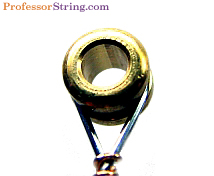 |
Perhaps the most common ball-end has a barrel shape with
a groove in the center. They are often made of brass. |
|
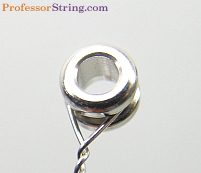 |
There has been a series of manufacturers who have used
stainless steel ball-ends, or chrome plated ball-ends.
The purpose of this is more cosmetic, than functional.
In some instances, this can be a cost reduction for
string companies. The cost of raw materials such as
steel, brass, and copper has sky rocketed in recent
years. This has been due to world market demands created
by many countries continuing to enter the market in
manufacturing and free trade. The trend is likely to
continue. |
|
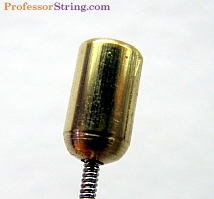 |
As
an effort to eliminate the "loop" commonly found on
ball-ends, the bullet shape gained popularity amongst
tremolo bridge users. The loop often contributed to
tuning issues. The bullet shape was a break through in
traditional thinking about string termination. It
eliminated many of the issues with the ball-end loop.
The selection of strings with this type of termination
is still fairly limited on the market. |
|
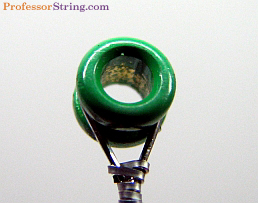 |
In
more recent years, manufacturers have powder coated and
painted the ball-ends. This allows for various color
coding schemes. In some cases, this enables brand
recognition for string manufacturers. Notice the inside
of the barrel is lacking pigment as it is difficult to
get full coverage into the barrel. This is purely a
cosmetic issue, and has no effect on the string’s
performance. |
|
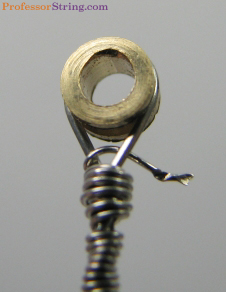 |
Sloppy workmanship, poor tooling, and cheap materials
are apparent in this unrefined ball-end. This is how
the ball-end looked, brand new, out of the package. This
was part of a free set of strings a major guitar
retailer was giving away. This particular string was
made in Korea. String sets given away for store
promotions will have this type of low quality ball-end.
When we checked the material hardness of the brass
ball-end, we found it to be considerably softer than
most other ball-ends we checked. Notice the wrap termination was not
secured. Upon further examination under the microscope,
we found the outer wrap-end to be "pinched" off rather
than a clean sliced cut. This is an indication of a
dull, or worn cutter needing replaced or sharpened.
Everything about this string screamed cheap and
low-buck. |
|
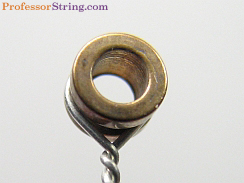 |
This
ball-end is from a string set made in China. It is a low grade brass
that allows for ultra low cost strings. Although we
found this particular string to have other issues, the
twist in the loop is fairly tight and well done. This makes it
friendly to bridges with narrow string channels. |
|
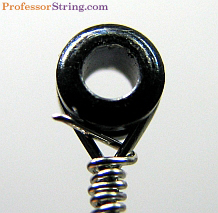 |
This string is brand new, and
demonstrates another ball-end loop with poor
workmanship. The ball-end is contoured brass that has
been nicely powder coated black. This is a string that
was made in the USA by a very well known string company.
Notice the excess string winding resting against the
ball-end. This is perhaps one of the worst
types of errors in terminating the outer winding. In
this case, the ball-end potentially will never seat
properly in the bridge due to the excess winding being
in the way. As a result, the string may not stay in tune
properly. In short, this string should have been
rejected at the factory. Unfortunately, we have found
many string companies are not inspecting for this type
of error. |
As you can
see there are many differences in the ball-end. What does a
ball-end accomplish in terms of tone and playability? The
answers can vary as there are many things, bridge related, to
the performance of a ball-end. The first place to look is the
loop and twist.
Loop Patterns
The
loop is the portion of string where the wire has been looped
back onto itself and “twisted” around the ball-end. The loop
pattern has always been a point taken for granted by the
majority of musicians. Many glance at the twist and visually
acknowledge whether or not there is enough wrap to hold the
ball-end in place while the string is under tuning tension. Take
a look at the two twists below. Notice how the Loop Pattern 1 on
the left is tighter than Loop Pattern 2 on the right. In Loop
Pattern 3, there is no loop. The ball-end loop has been
eliminated in this particular design. Depending on the bridge or
tailpiece design, the ball-end loop will have a profound effect
on tuning.
|
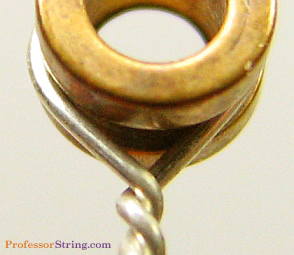
Loop Pattern 1 |
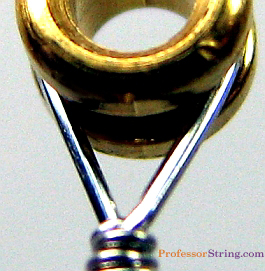
Loop
Pattern 2 |
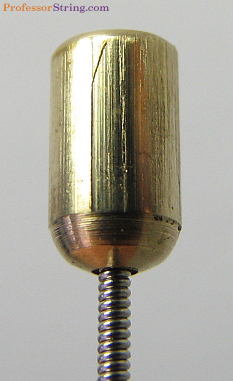
Loop Pattern 3 |
Spring Effect
As
previously mentioned, the loop can have a profound effect on
tuning. Some bridge/tailpiece designs require the ball-end and
twist to be completely cut off. Such tailpieces eliminate the
issues found with ball-ends and loops. The majority of
tailpieces and bridges on the market utilize the ball-end and
loop. When dealing with a loop such as Loop Pattern 2 (above), there
is a drawback to having excessive tangential slack in the loop. To
illustrate how the loop effects tuning, we are going to examine
one particular scenario we call the "Spring Effect" in the loop.
|
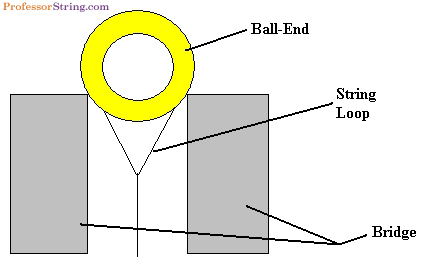
Figure 1
|
In
this illustration we are seeing a cross sectional view
of the bridge or tailpiece. We are also seeing a
properly seated ball-end. The ball is resting on the
bridge as it is under tension. Notice how the string
loop is not in contact with anything on the bridge. The
loop is isolated via suspension from the instrument. In
effect, the loop and string are floating. |
|
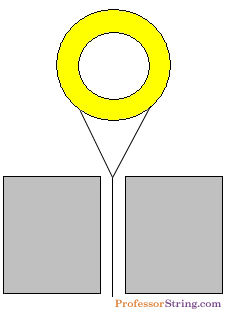
Figure 2
|
In
this illustration, again we are seeing a cross sectional
view of the bridge or tailpiece. In this design, the
string channel is much narrower. The loop is about to
touch the bridge, before full tension is reached. In
this situation, the loop is not going to be floating. |
|
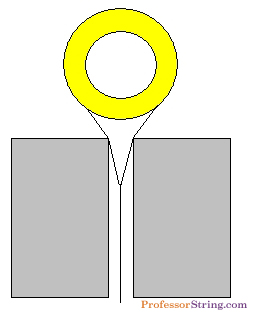
Figure 3
|
As
the string is tensioned to a tuned state, the loop
begins to compress. The compressing of the loop makes
the ball-end want to spring back against the string. We
call this the Spring Effect. It effects the tuning of
the string. |
|

Figure 4 |
Once
the string is fully tuned, the ball seats against the
bridge. At the same time, the loop retains its Spring
Effect. In some cases the Spring Effect is so strong;
the ball never anchors to the bridge. |
Results
In the figure Loop 1, below shows a
brand new string with a fairly loose ball-end loop. This is a
string from a company with a very well known brand in the
industry. The core string has good uniformity in its shape. In
addition, you can see the normal extrusion marks, or lines, from
when it was drawn into the proper gauge diameter and hex shape.
In Loop 2, the same exact string was installed on a guitar. The
guitar had a tailpiece bridge with narrow string channels. As
you can see, there were dig
marks created on the core string from the Spring Effect. In
fact, a small tiny metal burr has developed on the string. The marks are created by the bridge digging into the
ball-end loop. This occurs once the string has been tightened to tuning tension.
Additional micro-movement by a string being bent or stretched
can create deeper marks potentially creating a stress point that
can cause the string to eventually break at the loop. Aside from
poorly twisted ball-end loops, bridges and tailpieces that have
narrow string channels, without good chamfering and port holes,
some string brands
are notorious for causing the Spring Effect. If you are
interested in knowing how to diagnose this problem, and finding the
right strings without the potential Spring Effect problem, check
out Professor String's new
eBook.
|
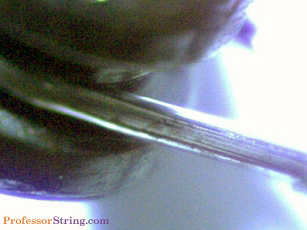
Loop 1 |
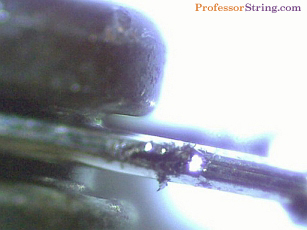
Loop 2 |
|
---------------------------------------------------------------------------------------------------------

Be
sure to sign-up for the Professor String's
Newsletter! |
|
|
|

